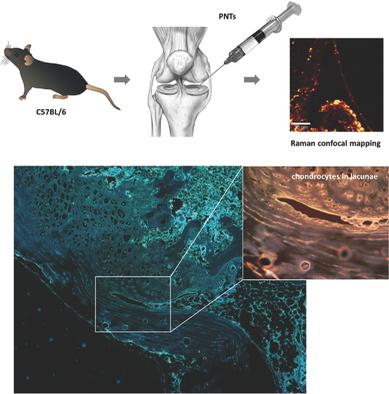当前位置:
X-MOL 学术
›
Adv. Healthcare Mater.
›
论文详情
Our official English website, www.x-mol.net, welcomes your feedback! (Note: you will need to create a separate account there.)
Nitric Oxide Dependent Degradation of Polyethylene Glycol‐Modified Single‐Walled Carbon Nanotubes: Implications for Intra‐Articular Delivery
Advanced Healthcare Materials ( IF 10.0 ) Pub Date : 2018-01-15 , DOI: 10.1002/adhm.201700916 Kunal Bhattacharya 1 , Cristiano Sacchetti 2, 3 , Pedro M. Costa 1 , Jens Sommertune 4 , Birgit D. Brandner 4 , Andrea Magrini 5 , Nicola Rosato 6 , Nunzio Bottini 2, 3 , Massimo Bottini 6, 7 , Bengt Fadeel 1
Advanced Healthcare Materials ( IF 10.0 ) Pub Date : 2018-01-15 , DOI: 10.1002/adhm.201700916 Kunal Bhattacharya 1 , Cristiano Sacchetti 2, 3 , Pedro M. Costa 1 , Jens Sommertune 4 , Birgit D. Brandner 4 , Andrea Magrini 5 , Nicola Rosato 6 , Nunzio Bottini 2, 3 , Massimo Bottini 6, 7 , Bengt Fadeel 1
Affiliation

|
Polyethylene glycol (PEG)‐modified carbon nanotubes have been successfully employed for intra‐articular delivery in mice without systemic or local toxicity. However, the fate of the delivery system itself remains to be understood. In this study 2 kDa PEG‐modified single‐walled carbon nanotubes (PNTs) are synthesized, and trafficking and degradation following intra‐articular injection into the knee‐joint of healthy mice are studied. Using confocal Raman microspectroscopy, PNTs can be imaged in the knee‐joint and are found to either egress from the synovial cavity or undergo biodegradation over a period of 3 weeks. Raman analysis discloses that PNTs are oxidatively degraded mainly in the chondrocyte‐rich cartilage and meniscus regions while PNTs can also be detected in the synovial membrane regions, where macrophages can be found. Furthermore, using murine chondrocyte (ATDC‐5) and macrophage (RAW264.7) cell lines, biodegradation of PNTs in activated, nitric oxide (NO)‐producing chondrocytes, which is blocked upon pharmacological inhibition of inducible nitric oxide synthase (iNOS), can be shown. Biodegradation of PNTs in macrophages is also noted, but after a longer period of incubation. Finally, cell‐free degradation of PNTs upon incubation with the peroxynitrite‐generating compound, SIN‐1 is demonstrated. The present study paves the way for the use of PNTs as delivery systems in the treatment of diseases of the joint.
中文翻译:

聚乙二醇修饰的单壁碳纳米管的一氧化氮依赖性降解:对关节内递送的影响
聚乙二醇(PEG)修饰的碳纳米管已成功用于小鼠的关节内递送,而没有全身或局部毒性。但是,交付系统本身的命运还有待了解。在这项研究中,合成了2 kDa PEG修饰的单壁碳纳米管(PNT),并研究了向健康小鼠的膝关节内注射后的运输和降解。使用共聚焦拉曼光谱法,可以在膝关节中对PNT成像,并发现其从滑膜腔流出或经过3周的生物降解。拉曼分析表明,PNTs主要在富含软骨细胞的软骨和半月板区域被氧化降解,而在滑膜区域也可以检测到PNTs,在那里可以发现巨噬细胞。此外,使用鼠软骨细胞(ATDC-5)和巨噬细胞(RAW264.7)细胞系,可以在活化的产生一氧化氮(NO)的软骨细胞中对PNT进行生物降解,这种药物在药理学上抑制诱导型一氧化氮合酶(iNOS)时被阻止如图所示。还指出了巨噬细胞中PNT的生物降解,但经过较长时间的温育。最后,证明了与过氧亚硝酸盐生成的化合物SIN-1孵育后PNT的无细胞降解。本研究为在治疗关节疾病中使用PNTs作为递送系统铺平了道路。还指出了巨噬细胞中PNT的生物降解,但经过较长时间的温育。最后,证明了与过氧亚硝酸盐生成的化合物SIN-1孵育后PNT的无细胞降解。本研究为在治疗关节疾病中使用PNTs作为递送系统铺平了道路。还指出了巨噬细胞中PNT的生物降解,但经过较长时间的温育。最后,证明了与过氧亚硝酸盐生成的化合物SIN-1孵育后PNT的无细胞降解。本研究为在治疗关节疾病中使用PNTs作为递送系统铺平了道路。
更新日期:2018-01-15
中文翻译:

聚乙二醇修饰的单壁碳纳米管的一氧化氮依赖性降解:对关节内递送的影响
聚乙二醇(PEG)修饰的碳纳米管已成功用于小鼠的关节内递送,而没有全身或局部毒性。但是,交付系统本身的命运还有待了解。在这项研究中,合成了2 kDa PEG修饰的单壁碳纳米管(PNT),并研究了向健康小鼠的膝关节内注射后的运输和降解。使用共聚焦拉曼光谱法,可以在膝关节中对PNT成像,并发现其从滑膜腔流出或经过3周的生物降解。拉曼分析表明,PNTs主要在富含软骨细胞的软骨和半月板区域被氧化降解,而在滑膜区域也可以检测到PNTs,在那里可以发现巨噬细胞。此外,使用鼠软骨细胞(ATDC-5)和巨噬细胞(RAW264.7)细胞系,可以在活化的产生一氧化氮(NO)的软骨细胞中对PNT进行生物降解,这种药物在药理学上抑制诱导型一氧化氮合酶(iNOS)时被阻止如图所示。还指出了巨噬细胞中PNT的生物降解,但经过较长时间的温育。最后,证明了与过氧亚硝酸盐生成的化合物SIN-1孵育后PNT的无细胞降解。本研究为在治疗关节疾病中使用PNTs作为递送系统铺平了道路。还指出了巨噬细胞中PNT的生物降解,但经过较长时间的温育。最后,证明了与过氧亚硝酸盐生成的化合物SIN-1孵育后PNT的无细胞降解。本研究为在治疗关节疾病中使用PNTs作为递送系统铺平了道路。还指出了巨噬细胞中PNT的生物降解,但经过较长时间的温育。最后,证明了与过氧亚硝酸盐生成的化合物SIN-1孵育后PNT的无细胞降解。本研究为在治疗关节疾病中使用PNTs作为递送系统铺平了道路。



























 京公网安备 11010802027423号
京公网安备 11010802027423号